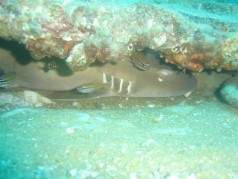| Great Barrier Reef
Diving with ''Bargara Beach Dive'' a wreck dive.
Nice wreck and also a Shark
Comments
This artificial reef is a great success story. The prolific and diverse marine life that resides and visits the area is proof that these reefs work extremely well.
Our dive boat 'Narcosis' has conducted over two hundred & fifty trips to the reef in the past 2 years with over 1,500 dives conducted. Our staff have an intimate knowledge of all the sites and will ensure that you miss nothing.
Special recognition must be made of Alan & Brenda Cochrane who spent many years fighting red tape to gain permission for the formation of the reef. The members of the Artificial Reef Committee and local divers who supported the project should also be congratulated on its outstanding success.
The Queensland Department of Primary Industries - Fisheries Research Division have adopted the reef as a field study site to assist in formulating policies for future artificial reef proposals.
Suitable For ...
Novice or experienced scuba divers (average depths about 15 - 18 metres). This site is an absolute must for visiting divers.
Average Visability
5 - 20 metres
Depths
15 - 18 metres
Bottom Topography
Flat sandy bottom with occasional patches of scattered sea grass.
Cautions
Marine growth over the structures often results in minor cuts to the hands of less experienced divers and gloves are recommended.
Being a popular fishing location, the sites often have monofiliment line and hooks hanging off the extremities.
Stone fish reside on the Ceratodus II and are usually found on the upper ledge at the stern and occasionally on the sand around the wreck. Be aware of their presence and watch your buoyancy control.
Before entering the wreck of the Ceratodus II check with the locals for the best and safest entry/exit points and don't forget your torch. Entering the aircraft may stir up the silt so take care with you finning techniques and consider those following you.
Getting There
Situated approximately 3 nautical miles off the coast from Elliott Heads this site is without doubt our most sought after dive location. Accessed by either a fifteen minute boat trip from Bargara Beach or a ten minute trip from the Elliott River this location offers a variety of individual sites including; the 33 metre wreck of the 'Ceratadus II' (Sand Dredge), two Mohawk aircraft, King Air aircraft, water tower and a huge variety of specially constructed concrete modules, pipes and assorted other structures.
Marine Park Status
General Use Zone - Some restrictions apply
( Click here for information on zonings )
Marine Life
The expanse on the Artificial Reef site provides for a vast variety of marine life. Apart from the large structures such as the wreck of the dredge and the aircraft, a number of specifically designed modules have been constructed and placed as part of an ongoing experiment to determine the suitability of certain designs in attracting certain fish species. Pyramids of concrete pipes, perforated steel plates and concrete block modules are being appraised.
The wreck of the former sand dredge, 'Ceratodus II' has been submerged the longest (approximately 8 years) and features the most abundance of fish life on the reef. Huge schools of bait fish such as herring, sprat, whiptails and yakka cruise over the site and are often so thick that they obscure the wreck from view. The bow section (facing South) attracts the most life with large coral trout, sweetlip and many huge estuary cod seeking refuge under the rigging.
Lion fish are often seen suspended around the bow along with angelfish, butterfly fish, striped sea perch, parrot fish and tusk fish. Damsels nest on patches of the wreck that they clear of algae before laying thousand of small purple eggs at the beginning of Summer.
Huge grouper measuring 1.5 - 2 metres long are occasionally seen around the site and are now getting used to the presence of divers, allowing them a closer inspection of these awesome fish.
Olive sea snakes frequent the site as do well camouflaged stone fish.
Loggerhead and green turtles are often found nestled under the side of the wreck or under the stern alongside the ever present wobbegong (carpet) sharks.
A two metre leopard shark is usually resident in the area during Summer and disappears during Winter while a large shovelnose ray is also a frequent visitor.
In recent times (late 1998) there have been a few isolated and confirmed sightings of tiger sharks that have been feeding on the schools of bait fish. Spanish mackerel also feed on the site along with large schools of dolphins.
The aircraft host a similar variety of life although usually not so abundant. The scattered modules around the site also host many species including red emperors.
The Artificial Reef is a huge success and is a must for any visiting diver.
|
| |

